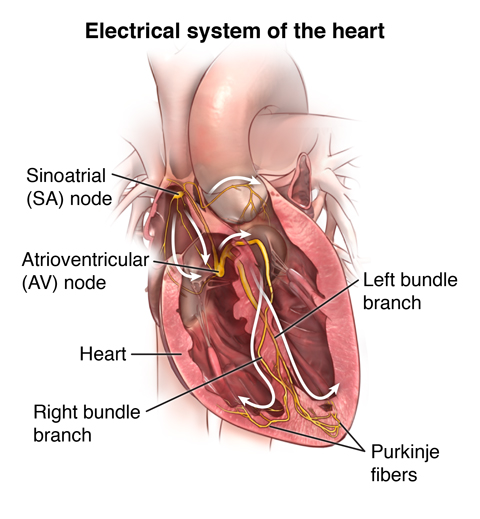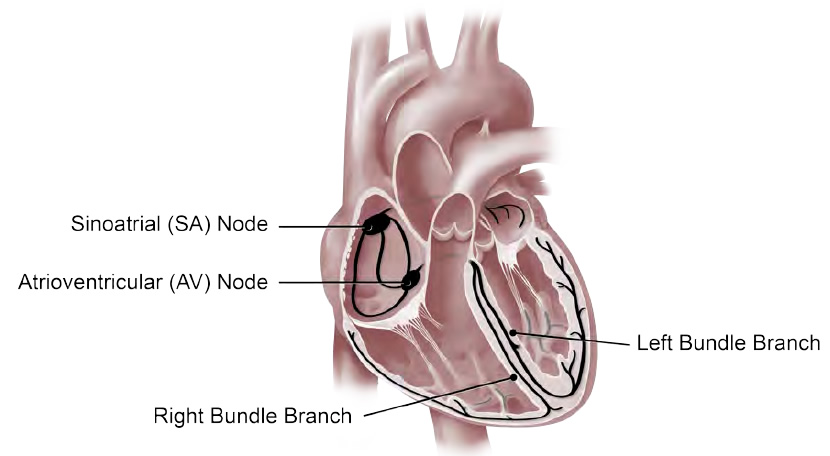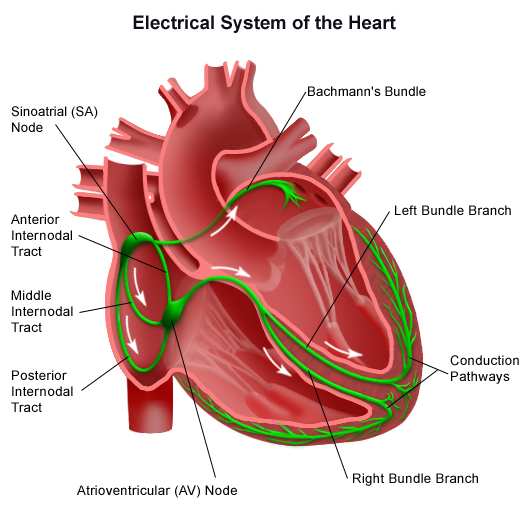Describe the Electrical System That Controls the Heartbeat
Heart rhythm which is the synchronized pumping action of your four heart chambers. Heart rate which is the number of times your heart beats per minute.

Anatomy And Function Of The Heart S Electrical System Johns Hopkins Medicine
Your hearts electrical system controls the rate and rhythm of your heartbeat.

. These two nodes are the sinoatrial SA node and the atrioventricular AV node. SA node sinoatrial node known as the hearts natural pacemaker. The impulse starts in a small bundle of specialized cells located in the right atrium called the SA node.
The sinoatrial SA node located in the right atrium of your heart. If disease or injury weakens your heart your bodys organs will not receive enough blood to. Cardiac conduction is the rate at which the heart conducts electrical impulses.
All this activity produces electrical waves we can measure. The electrical system also is called the cardiac conduction system. A healthy heart supplies your body with the right amount of blood at the rate needed to work well.
The cardiac conduction system is a network of specialized cardiac muscle cells that initiate and transmit the electrical impulses responsible for the coordinated contractions of each cardiac cycleThese special cells are able to generate an action potential on their own self-excitation and pass it on to other nearby cells conduction including cardiomyocytes. Two different types of cells in your heart enable the electrical signal to control your heartbeat. On the other hand parasympathetic innervation decreases the rhythmicity and conduction decreasing the heart rate.
It induces the force of contraction of the heart and its heart rate. Your heart beats as a result of the generation and conduction of electrical impulses. S-A node A-V node and His.
The parasympathetic nerves do the opposite. The hearts pacemaker sends out an electrical signal impulse that spreads throughout the heart along electrical pathways. The sympathetic nerves increase the heart rate and increase the force of contraction.
The conduction system of the heart controls its pumping action which results in the delivery of blood to the different organs and tissues of the body. The cardiac conduction system is the electrical pathway of the heart that leads to atrial and ventricular contraction. The electrical conduction system that controls the heart rate.
Your hearts electrical system controls the timing of your heartbeat by sending an electrical signal through these cells. 1The electrical signal travels through the network of conducting cell pathways which stimulates your upper chambers atria and lower chambers ventricles to contract. Sympathetic innervation increases the rhythmicity of the SA node and the heart rate increases.
These signals cause different parts of your heart to expand and contract. The conduction system consists of pacemaker cells that generate spontaneous action potentials and then deliver those impulses throughout the heart. Hearts electrical path and reading an EKG.
The heart test called an ECG electrocardiogram is a graphical picture of the hearts electrical activity. In addition it controls the peripheral resistance of blood vessels. Name the 3 parts of your hearts electrical system.
Conducting cells carry your hearts electrical signal. Terms in this set 22 electrical system controls the speed of your. The atrioventricular AV node located on the interatrial septum close to the.
The autonomic nervous system ANS is responsible for controlling many physiological functions. Each time your heart beats electrical signals travel through your heart. Electrical signals arising in the SA node located in the right atrium stimulate the atria to contractThen the signals travel to the atrioventricular node AV node which is located in the interatrial septumAfter a delay the electrical signal diverges and is conducted through the left and right bundle of His to the respective Purkinje fibers for each side of the heart as well as to.
These pathways transmit the signal from the upper to the lower chambers of the heart which causes the heart muscle to contract. 2The signal is able to travel along these pathways by means of a complex reaction that allows each cell to activate one next to it stimulating it to pass along the electrical signal in an orderly manner. The SAN is found in the top of the right atrium.
Conduction System of the Heart. This system generates electrical impulses and conducts them throughout the muscle of the heart stimulating the heart to contract and pump blood. When nodal tissue contracts like muscle tissue it generates nerve impulses like nervous tissue that travel throughout the heart wall.
The SA node and the AV node receive innervations from the autonomic nervous system for the control of heart rate. The Autonomic Nervous System. These impulses cause the heart to contract and then relax.
The heart has two nodes that are instrumental in cardiac conduction which is the electrical system that powers the cardiac cycle. The heart conduction system is the network of nodes cells and signals that controls your heartbeat. Your hearts electrical system is made up of three main parts.
Muscle cells enable your hearts chambers to contract an action triggered by. Your heart muscle is made of tiny cells. Your heartbeat is triggered by electrical impulses that travel down a special pathway through your heart.
This conduction system is composed of a group of special cells found in the walls of the heart muscle which send the electrical impulses and cause the heart muscle to contract. The expansion and contraction control blood flow through your heart and body. The autonomic nervous system has two parts - The sympathetic nervous system and the parasympathetic nervous system.
The heartbeat starts in the heart itself due to the sino-atrial node SAN. Cardiac conduction system. The electrical system of your heart is the power source that makes this possible.
Regular rhythmic electrical signals keep the heart pumping blood to the lungs and the body. Among the major elements in the cardiac conduction system are the sinus node atrioventricular node and the autonomic. Your hearts electrical system controls the timing of your heartbeat by regulating your.

How The Heart S Electrical System Works Heart Electrical Nurse Pharmacology Nursing

The Heart S Electrical System University Of Ottawa Heart Institute

No comments for "Describe the Electrical System That Controls the Heartbeat"
Post a Comment